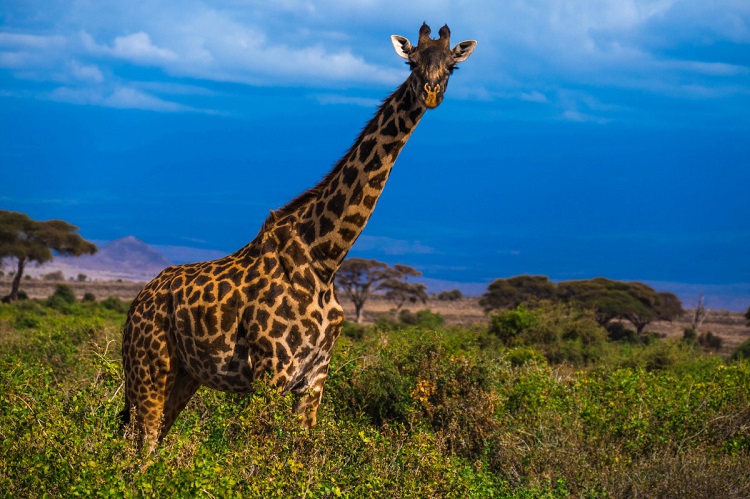Overview
The giraffe is quite a comical-looking character with its peculiar body shape and characteristics. We don’t want to body shame it, but it is kinda weird looking. Yet, at the same time, it is elegant and goofy, which is why most people love this gorky creature.
We will take you through a detailed walk (slow, unlike the vast strides of the Giraffa) through this animal’s lineage and subspecies. We will also share with you some of its intelligent physical design highlights and cultural highlights.
No discussion of the world’s tallest animal would be complete without fun facts or the sad side of conservation, either. So, join us for a perusal of the Giraffa camelopardalis’ magnificent qualities across several African countries.
Etymology
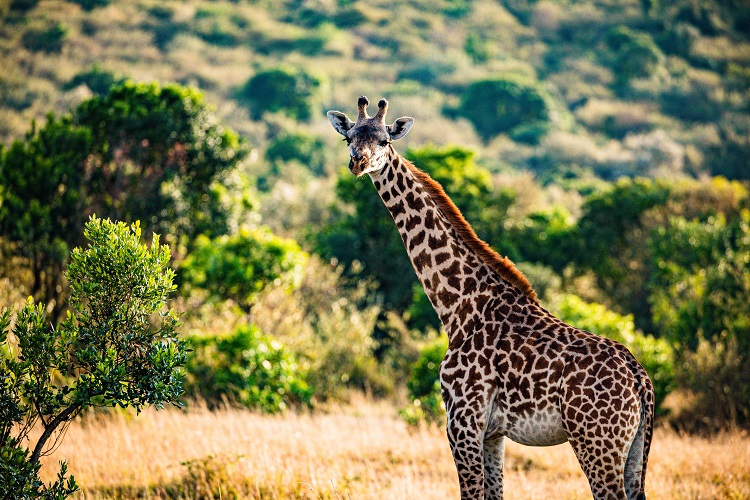
Zarāfah is an Arabic word with Persian origins and the compound of zurnā and pā, meaning flute and leg. Other contributions to the giraffe’s name come from early English, based on the Arabic word.
Later, the Italian and French languages also influenced the current name. Ancient Greek also contributed to the camelopard (camel and leopard because of the shape and markings), leading to the name of the giraffe today.
What Do Giraffes Look Like?
Giraffes have long sloping bodies from the head down to the tufted giraffe tails. Their bodies are pretty robust and rectangular-shaped, and they have broad chests. Their legs are long and slender.
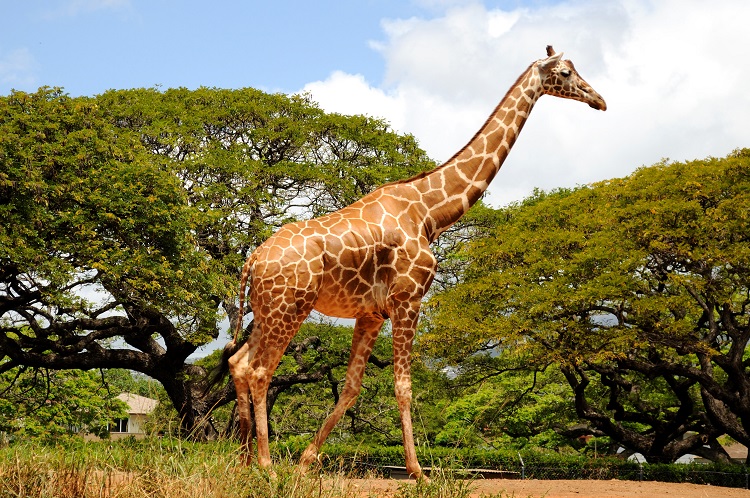
The appearance of the giraffe is simultaneously elegant and awkward because of its incredibly long, powerful neck, topped by a delicate-looking face. Its face has a sweet look, huge eyes and long eyelashes, a short, pointed snout, big lips and teeth, and a long tongue.
At the top of its head are two long pointy ears on either side of two short furry little horns.
Most impressive are the beautiful coat patterns on these animals. They have a base color coat that is creamy to tawny. The shapes of the rosettes vary between subspecies, and the colors range from light brown to dark brown and almost black.
The giraffe has the most eye-catching appearance of all the land mammals that are herbivores. But although vulnerable looking, do not be deceived. This powerful animal is capable of warding off predators like lions, leopards, and hyenas.
Taxonomy
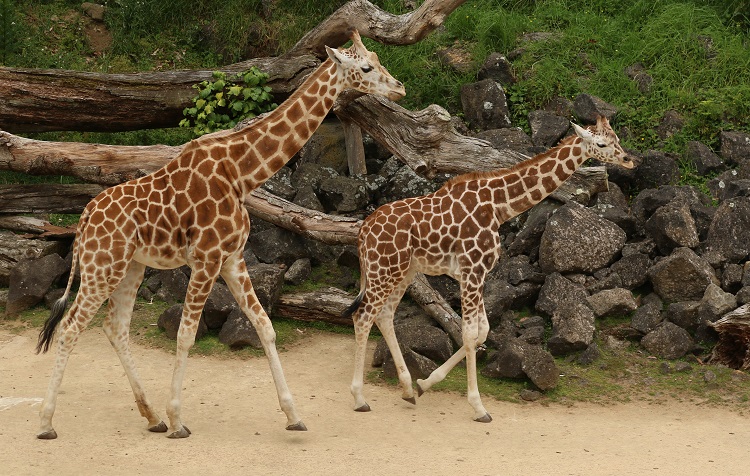
Taxonomy is the scientific categorization of organisms. Here we deal with the classification of the noble Giraffa camelopardalis in terms of its evolution, species, subspecies, and scientific classification. This explanation will give a good background of this magnificent, patterned creature we all love.
Evolution
The Giraffidae family has only two members left in the Artiodactyla order. One is the giraffe, and the other is the okapi. According to the fossils that scientists have found, there used to be ten members of this genus.
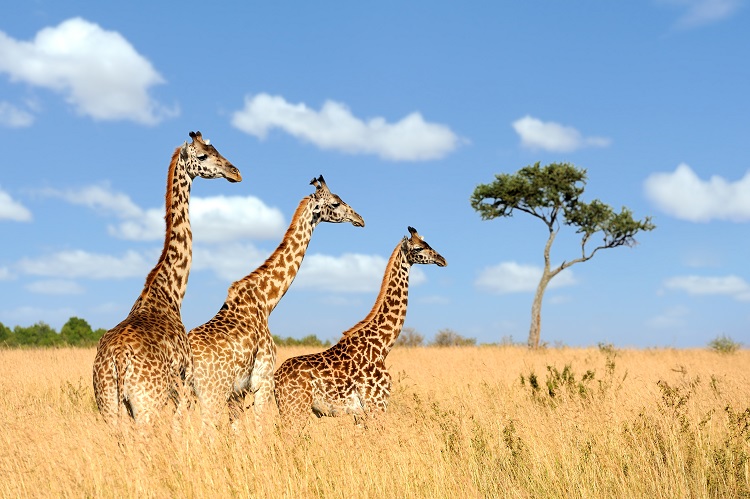
Graffid ancestors include the Canthumeryx, Giraffokeryx, Sivatherium, and Bramatherium. Other early family members are the Samotherium, Shansitherium, and Palaeotragus, which lived throughout Eurasia and India. These animals could have been the okapi’s ancestors.
But other scientists think the okapi ancestry split much earlier than the Giraffokeryx. Experts also believe that the Samotherium is a good candidate as the giraffe’s earlier ancestor because of the fossils they found. Even more likely, the Bohlinia was a direct ancestor since it closely resembled today’s species.
Today, it is unclear whether this animal is a descendant of G. jumae or G. gracilis, but they only live on the African continent. Another element of their evolution is that researchers have changed their classifications several times regarding species taxonomy.
Various theories of their evolution refer to four species, with some having two subspecies and other options. Today, the IUCN recognizes one species and nine subspecies.
Species and Subspecies
The research below follows the four distinct species and subspecies, including the Rothschild subspecies. If you include the Reticulated giraffe and the Rothschild giraffe as subspecies, you see the Giraffa camelopardalis is the primary species with the remaining nine subspecies.
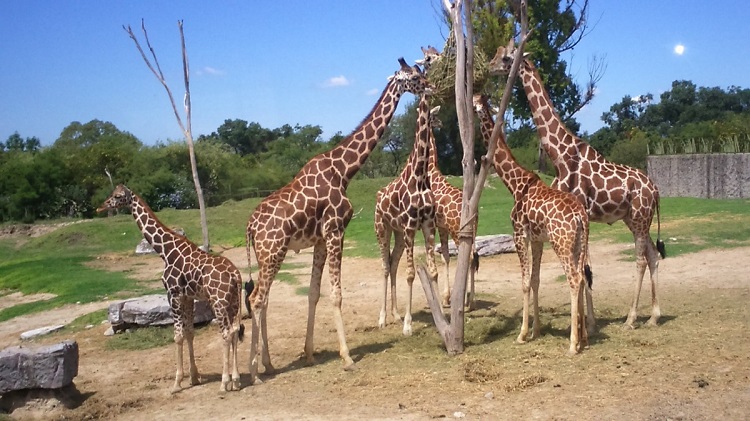
Giraffa camelopardalis or Northern Giraffe
- G. camelopardalis antiquorum (Kordofan giraffe). The Kordofan giraffes are present in the northeastern DR Congo, Chad, northern Cameroon, and the Central African Republic.
- G. c. camelopardalis (Nubian giraffe). Locations include Uganda, Kenya, eastern South Sudan, and southwestern Ethiopia.
- G. c. peralta (West African giraffe). This subspecies is widespread throughout southwestern Niger.
G. reticulata or Reticulated Giraffe or Somali Giraffe
- There are no subspecies for the reticulated giraffe. (Reticulated giraffes are native to Southern Ethiopia, Somalia, and Northeastern Kenya).
G. tippelskirchi or Masai Giraffe Sensu Lato
- G. tippelskirchi tippelskirchi (Masai giraffe sensu stricto or Masai giraffes). These Masai giraffes live in Tanzania and central and southern Kenya.
- G. t. thornicrofti (Luangwa or Thornicroft’s giraffe). This subspecies is only in eastern Zambia’s Luangwa Valley.
G. giraffa or Southern Giraffe
- G. giraffa angolensis (Angolan giraffe). This subspecies inhabits regions of northern Namibia, central Botswana, southwestern Zambia, and western and southern Zimbabwe.
- G. g. giraffa (Southern African giraffe). This subspecies lives in the north of South Africa, southern Botswana, and southwestern Mozambique.
Experts think that the Rothschild’s giraffe (G. c. rothschildi) may be the G. camelopardalis ecotype. Its habitats include Uganda and Kenya. It may also be present in South Sudan, but this presence is unconfirmed.
Scientific Classification
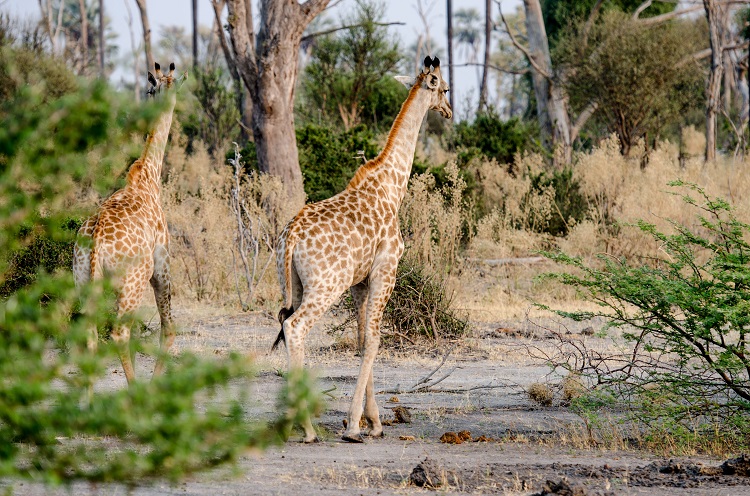
- Kingdom – Animalia
- Phylum – Chordata
- Class – Mammalia
- Order – Artiodactyla
- Family – Giraffidae
- Genus – Giraffa
Characteristics of Giraffe
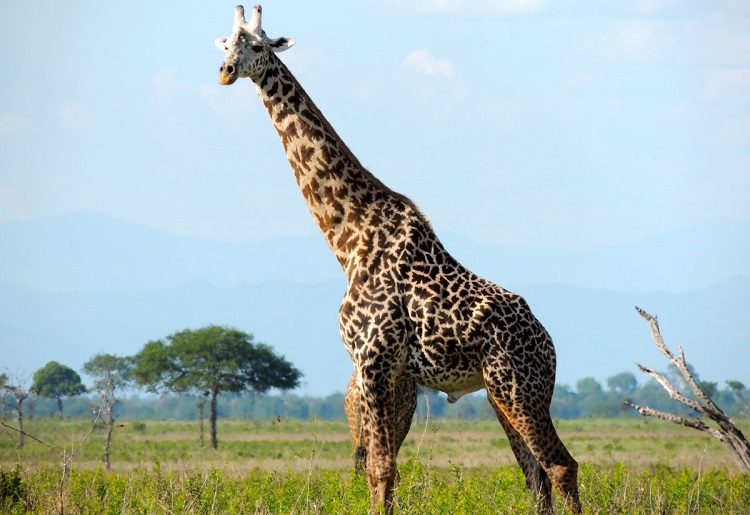
Adult giraffes are between 14 and 18 feet tall, some growing as high as 18.7 feet. The males weigh about 2,600 pounds, and the females weigh about 1,800 pounds. The Giraffa’s bodies are short and thickset, with long spines ending in a tail between 30 and 40 inches.
Their skin is tan or gray, and their coat pattern colors range from almost black to brown, chestnut or orange on a base of white or cream. Their patterning is excellent for camouflage in the savannah, so it isn’t easy to spot them under the dappled shade of trees even though they spend most of the day eating.
Giraffe skin grows to 20mm thick and contains a complex system that helps them regulate their temperatures. Another cool feature is that their coat hair contains at least 11 chemicals, which is pretty stinky but keeps the bugs away. This odor may also be present for sexual attraction.
Head
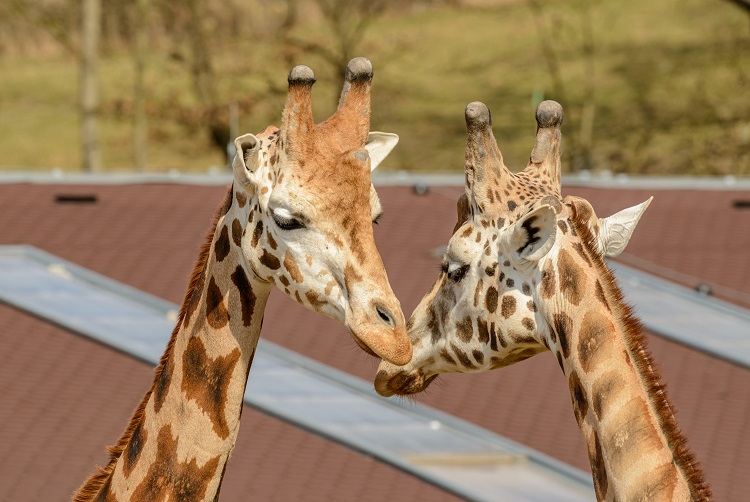
Giraffes have small horns covered in hair called ossicones, which might help with body temperature regulation. The male giraffe’s skull has a lump on the top of the head, which grows thicker and heavier with age.
It gets better! Their eyes have binocular vision, and they might be able to see color. Besides, their sense of smell is incredible, and they can hear well. They have long black tongues and prehensile lips that are incredibly flexible for ripping off foliage.
Instead of teeth in the upper mouth, they have a hard palate and 32 teeth in the bottom jaw – great for chewing the cud for ruminants.
Neck
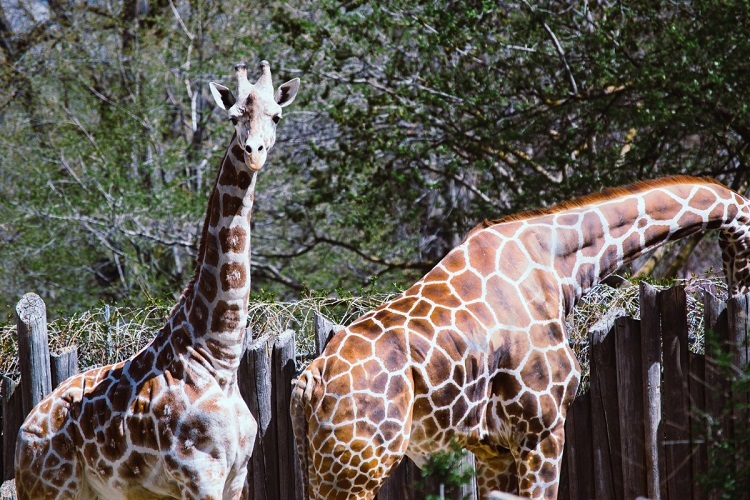
The giraffe has a long neck that can grow to almost eight feet and consists of nine vertebrae of about 11 inches each. It has a short mane and frequently lies at an angle of 50 to 60 degrees.
How Long Is a Giraffe’s Tongue?
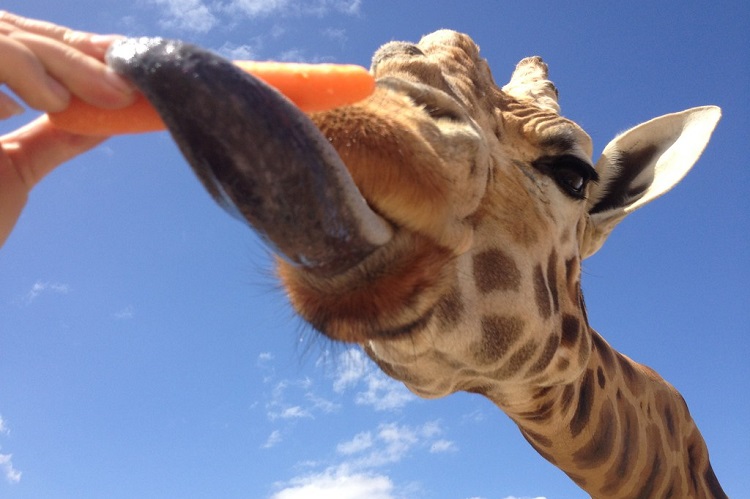
Those tongues grow to lengths of close to 60 inches, and they use them for everything, from eating to tasting urine in the mating season.
Legs, Locomotion, and Posture (How Long Are Giraffe’s Legs)
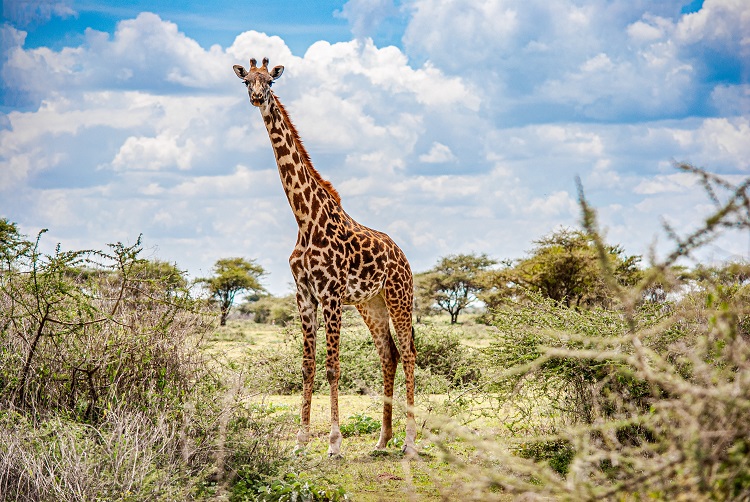
Giraffes have legs that can grow as long as six feet. The hind legs have large muscles, and the front and back legs are about the same length.
Giraffes can only gallop or walk, which they do by moving their front and rear legs in tandem. The back legs move in front of the forelegs when galloping.
From a suspensory ligament to a fetlock on its lower legs and a short pelvis with extended crests, the entire posture of giraffes is designed to support their weight.
Giraffes sleep with their head resting on their folded legs.
Internal Systems
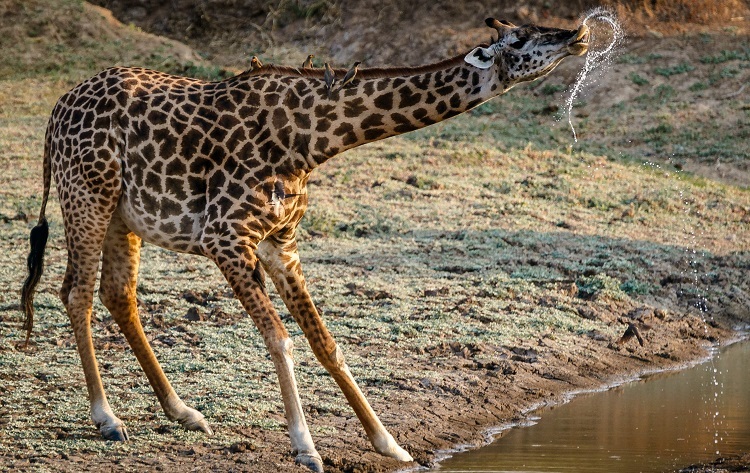
The giraffe’s recurrent laryngeal nerve on the left side is 12 inches longer on the right side.
Giraffes cool their brains through their nostrils by dissipating heat. Giraffes have a well-adapted circulatory system that beats 150 times a minute.
Another internal element is that they have strong esophageal muscles to regurgitate their food to ruminate. Their intestines measure up to 230 feet, which are adapted to their diets.
Behavior and Ecology
It’s time to find out about the magnificent giraffe’s social life and how it interacts with its environment.
Habitat and Feeding
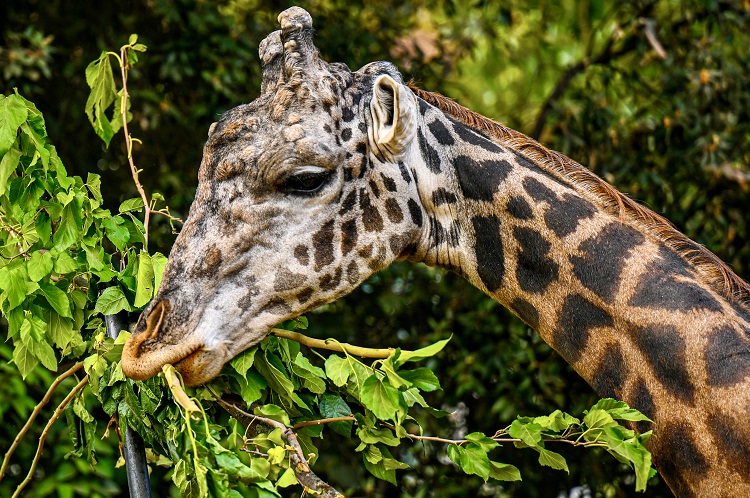
Giraffes live throughout Africa, from Southern Africa to northern Kenya and many other countries. They favor living in warm savannah regions or open woodlands but can also live in desert areas, like the Angolan giraffes.
Their food preferences are the Acacieae tree varieties like the Terminalia, Combretum, and Commiphora. These animals also snack on twigs, shrubs, fruit, and grass. Giraffes gather around the remaining vegetation in the dry season but spread out in the wet season when food is abundant.
Social Life
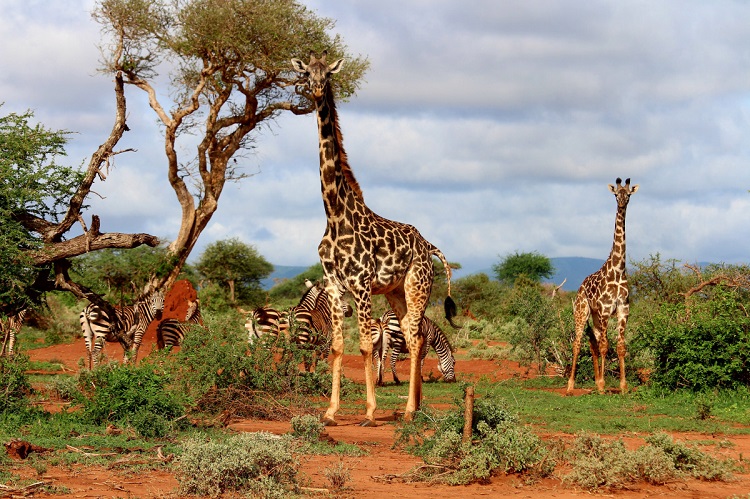
Giraffes congregate in groups that can be a kilometer apart (covering this distance in a few strides with six feet long legs is no problem). Smaller groups can socialize with larger ones of 60 to 90 female adult giraffes. Males giraffe groups of 300 animals can connect these smaller groups, creating super communities.
Reproduction and Parental Care
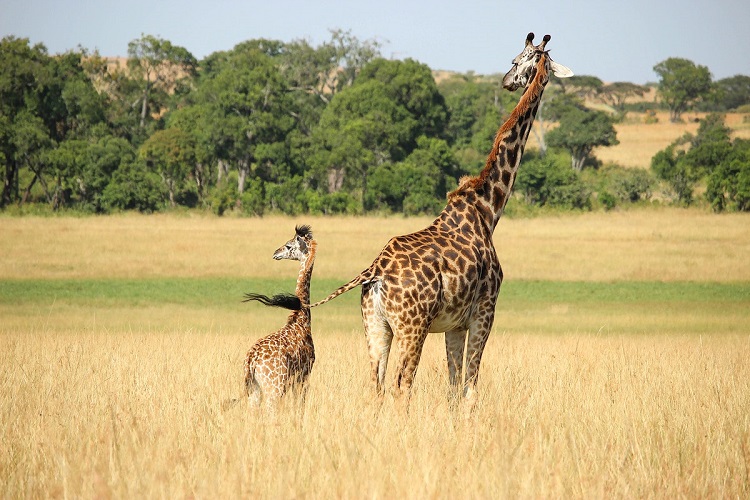
Giraffe reproduction is mainly polygamous, with males seeking out younger females for mating. Females go into oestrus about every fifteen days so that they can reproduce all year round.
Males use the flehmen response and test the female’s urine to check if she is in oestrus. Males rise on their hind legs and place their forelegs on the female’s sides while looking upwards when mating.
Unlike humans, poor female giraffes are pregnant for 15 long months. Spare a thought for the poor young giraffes that drop almost six feet because the mother gives birth standing up.
Mothers use a calving pool as a nursery. All females guard the calves, although mothers only alert their offspring to danger. But the others will act on hearing a warning.
Necking
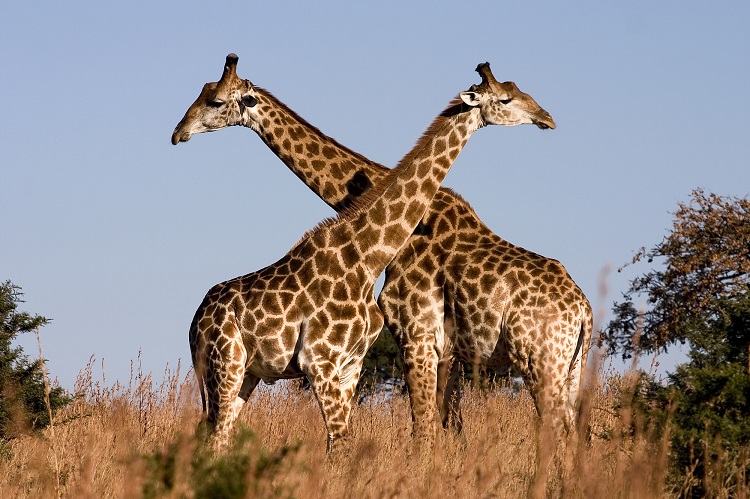
Two male giraffes do low or high-intensity necking, where they lean on or slam each other with their long necks and heads. Whoever stays the most upright wins the battle and enjoys more reproductive success.
Male giraffes also engage in same-sex mounting. Researchers record up to 94% of this behavior, with averages of 30 to 75% between males and only 1% between females.
Mortality and Health
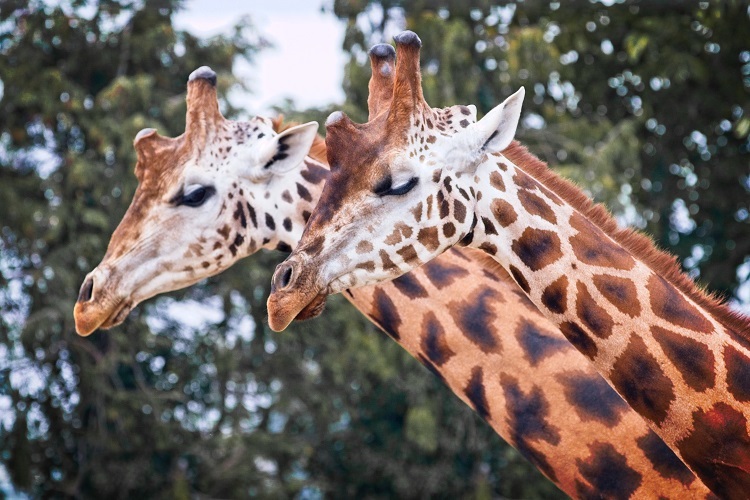
Only 25 to 33% of calves reach adulthood due to predation. But adult giraffes have a high chance of surviving and enjoying long lives.
Hanging around with giraffes is also helpful for other ruminants because giraffes can see far distances and warn them of danger. This advantage is mutual because large herds of zebra or wildebeest take the predator’s focus off giraffes.
Giraffes are susceptible to ticks, but Red-billed and Yellow-billed oxpeckers feed on ticks. They suffer from internal parasites, rinderpest, and skin diseases.
Giraffe Population
The Giraffe population has declined drastically in the past few decades, leading to major conservation concerns about their longevity as a species.
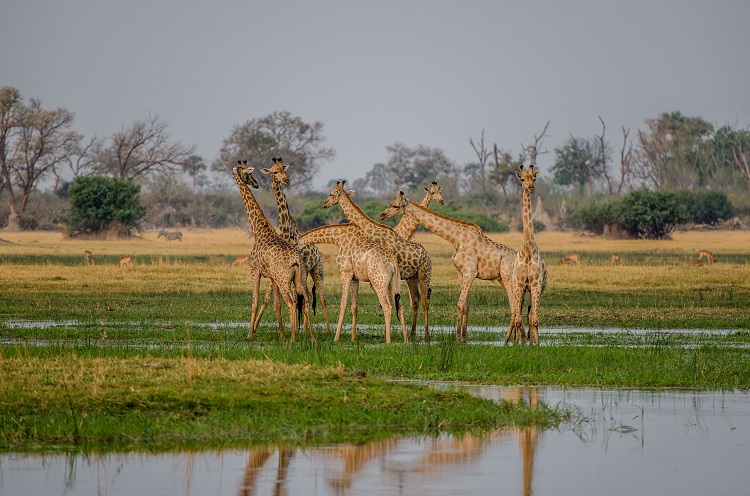
Living near people impacts their social behavior and population. People also chop down trees for firewood, depriving them of their food. Although giraffes co-exist well with livestock, droughts also kill vegetation, leading to starvation and death.
Conservationists use translocations to boost populations, but this strategy is dangerous and reaps little reward. But protected environments such as national parks are valuable in preserving their numbers since they also discourage poaching.
Another conservation approach is through community initiatives beyond the boundaries of a national park, which prove helpful in protecting these mammals. Private game reserves are another solution for their survival.
Relationship With Humans
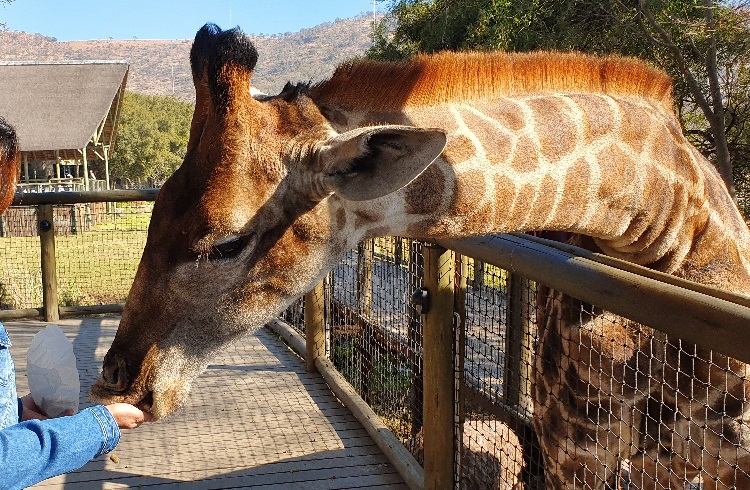
Cultural Significance
People have an enduring cultural relationship with giraffes. This connection extends from the caveman to modern man. It is reflected in art, symbols, royalty, stories, constellations, and science.
Captivity
Egyptians kept giraffes in captivity and sold them to the Romans. People transported them to the East, China, Italy, France, and many other countries.
Because they need large spaces to roam, their mortality rates in zoos in Europe and North America are much higher than when they wander free. People also keep them in captivity for breeding, conservation, and hunting purposes.
Exploitation
Giraffes have been the targets of hunters through the ages. They sell them for meat, their hair from which they make jewelry, shields, drum covers, sandals, and musical string instruments.
People use their burning smoke skin for nose bleeds and other traditional medicines. Hunters also kill giraffes for trophies.
How Long Do Giraffes Live? – Lifespan
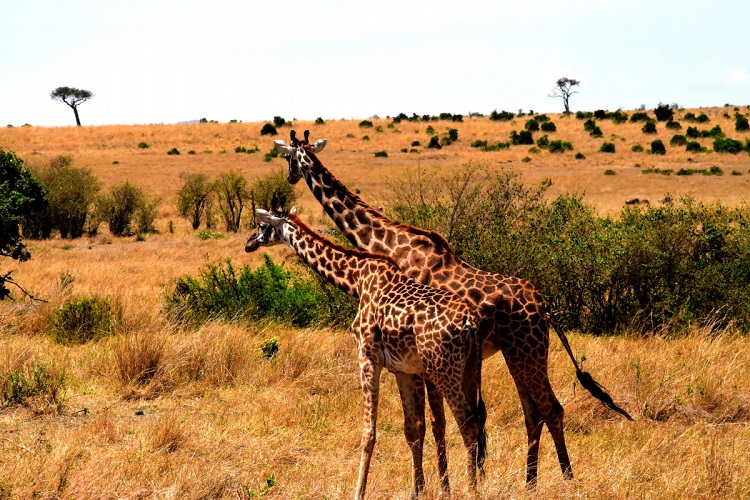
Giraffes have a lifespan of between ten and 15 years in the wild. But they live much longer in captivity, with the oldest living animal reaching 31 years. On average, they live between 20 and 25 years in captivity.
Fun Facts About Giraffes
Below are some interesting facts about this amazing animal.
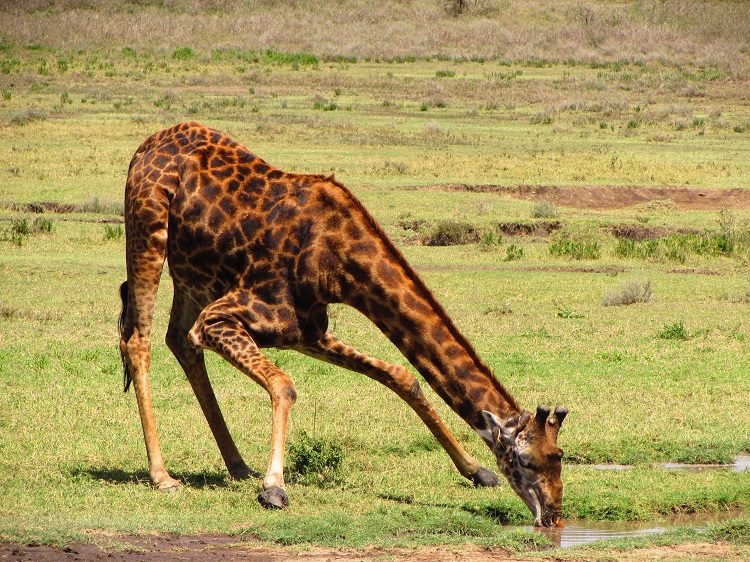
- The pattern of their coat is known as pelage.
- Coat patterns are unique, so no giraffe shares the same pelage.
- Giraffes are the tallest mammals on the earth, which is perfect for reaching the succulent leaves on tall trees.
- These mammals do not need much sleep (4.6 hours, mostly at night) and only take short naps of five to 30 minutes daily in brief, one to two minutes at a time.
- Giraffe calves can stand within half an hour after birth.
- These animals can reach speeds of 35 mph over short distances.
- Running over long distances, they can maintain speeds of about ten mph.
- They can cover 15 feet in a single stride – that’s how big they really are.
- Giraffes get most of their water from leaves, so they only drink at waterholes every few days.
- Just like people, they have 32 teeth. Unlike us, most of their teeth are molars. And they don’t need false ones even though all their teeth are on the bottom row of their mouths – strange but true!
- If you ever had a complex about the size of your feet – give it up. The giraffe’s hoof is the size of a large dinner plate (almost 12 inches). Mess with it, and it will kick the daylights out of you.
- Giraffa camelopardalis have big hearts. In fact, their hearts weigh up to 25 pounds and are as long as two feet.
- Eat your hearts out, ladies, because the giraffe’s eyelashes are at least half an inch long.
- Even bigger are those gorgeous doe-like eyes that grow to over 25 cubed inches.
- They lick, suck, and chew on animal bones – possibly to extract calcium.
How Many Giraffes Are in the World?
Like the mighty lion, giraffes are now on the IUCNs list of vulnerable species. Giraffes are so susceptible to extinction that fewer than 69,000 are left worldwide.
Of these, about 450 are housed in zoos. Giraffe populations have declined by almost 40% in the past three decades, leading to major conservation concerns about their longevity as a species.
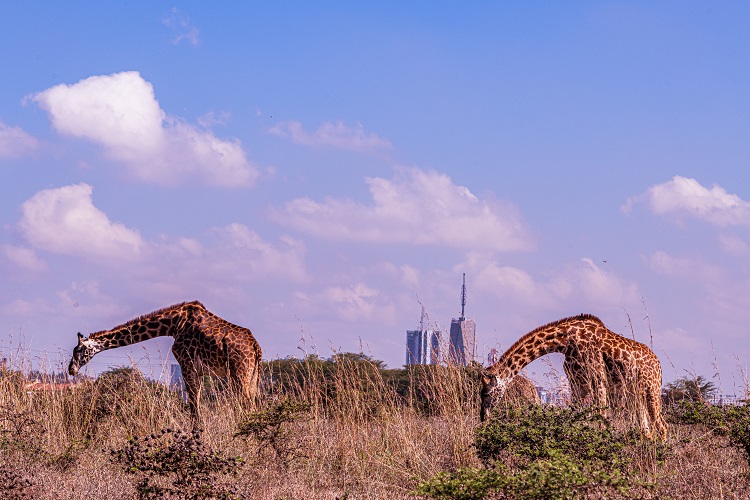
Giraffes are in such danger that many subspecies are already extinct, or authorities believe they are. Some examples include the following subspecies:
- Burkina Faso
- Malawi
- Mali
- Eritrea
- Guinea
- Mauritania
- Nigeria
- Senegal
Conservation Status – Are Giraffes an Endangered Species?
Giraffes are endangered, with less than 70,000 animals left in the wild. Giraffes are under threat from habitat loss, civil unrest, and more.
Threats to Survival
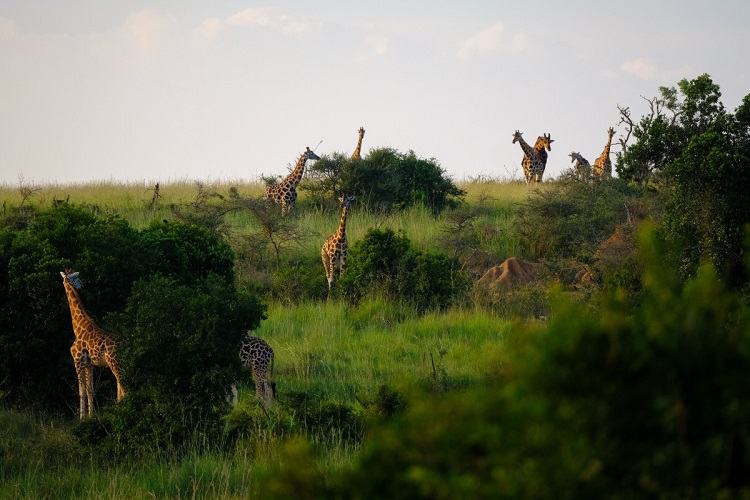
Giraffes face several threats in the wild, including poaching, hunting, and habitat destruction. As people continue to take up the giraffe’s habitat through mining, agriculture, and urban development, their space decreases or becomes degraded and fragmented.
This threat of environmental loss is so significant that the habitat of East African giraffe species has decreased by as much as 70% over the past 30 years. The Rothschild’s giraffe in West Africa (Kenya and Uganda) is also close to extinction – having landed on the IUCNs Red List of endangered and threatened species.
Another threat is that the bush meat trade in Africa is alive and flourishing. But its success is at the cost of the lives of the giraffe and several subspecies which have gone into extinction. Hunters also threaten the survival of this species.
What Can You Do To Help Giraffes?
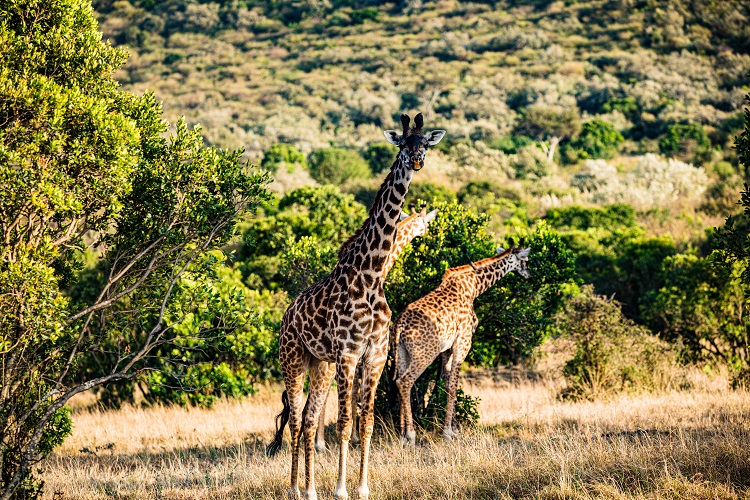
You can donate to the Giraffe Conservation Foundation to support the survival of these animals. This site is the only NGO (non-government organization) that focuses on conserving this vulnerable species, so adopt a giraffe today.
Why Are People Not More Aware of the Decline of Giraffe Populations?
Possible reasons for an absence of awareness of the giraffe’s plight include:
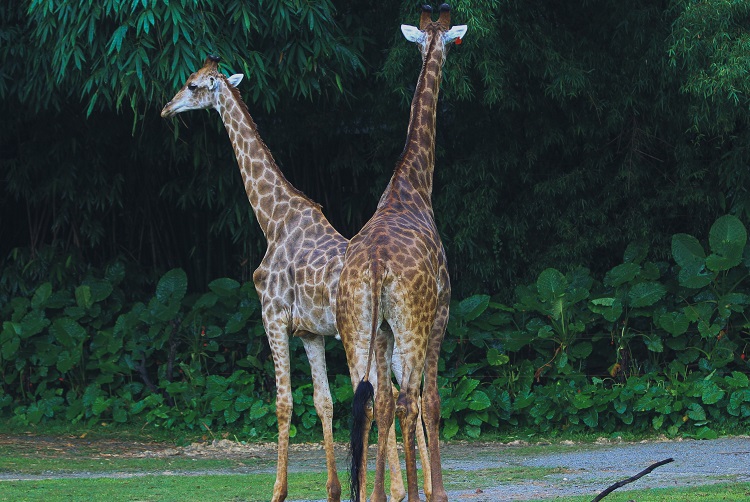
- They are native to the African continent, so people don’t think their survival concerns them.
- People are unaware that they are endangered.
- They believe that one person can’t help (which is why you can adopt a giraffe and make a difference as an individual).
FAQ’s
Is a Giraffe a Mammal?
Yes, the giraffe is a hoofed, cud-chewing mammal.
How Many Stomachs Does a Giraffe Have?
Giraffes are ruminant (cud-chewing) mammals with tummies that have four compartments. In other words, they have four stomachs to digest their food.
How Tall Are Giraffe Necks?
Giraffe necks can be as long as six feet on a fully-grown adult.
What Kind of Trees Do Giraffes Eat?
Giraffes sample vegetation by using their long necks to reach the tree tops where they eat leaves from the Acacia trees in Africa – their favorite. The other name for these trees is Vachellia or Senegalia trees.
Conclusion
Now that you have a better idea of who and what the Giraffa species is, we hope that you will help support its conservation.
This cutie deserves our respect. It also deserves to live freely, without the constant threat of being killed or losing what little living space it has left. Join a conservation drive to save this beautiful animal today.


